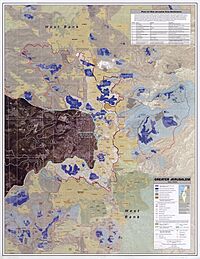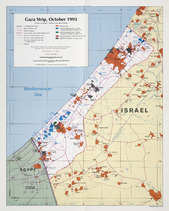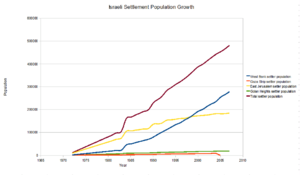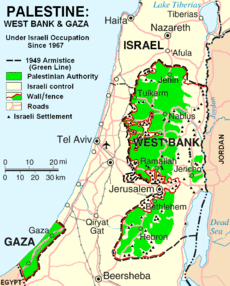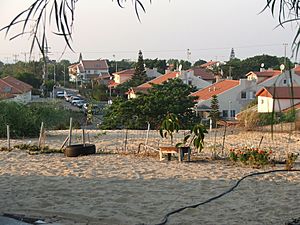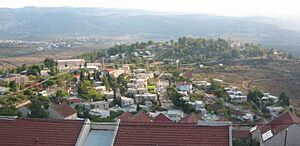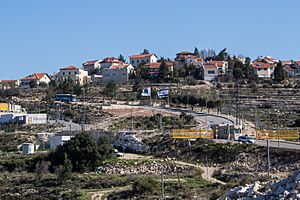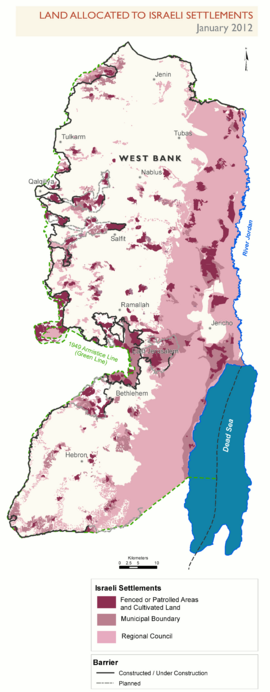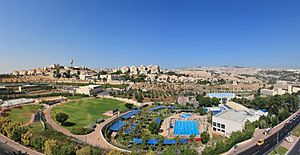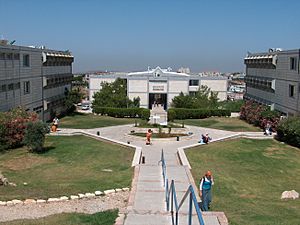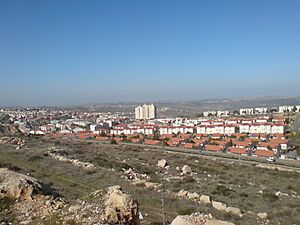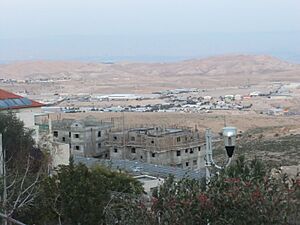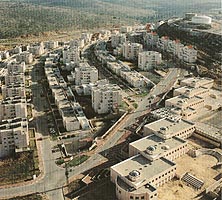Israeli settlement facts for kids
Israeli settlements are towns and villages built by Israel in lands it has occupied since the Six-Day War in 1967. These lands include the West Bank (including East Jerusalem) and the Golan Heights. Most people living in these settlements are Israeli citizens of Jewish background.
Many countries and international groups, like the United Nations (UN), believe these settlements are against international law. This is because international law says an occupying country should not move its own people into the land it occupies. However, Israel disagrees with this view. In 2024, the International Court of Justice (ICJ) said that Israel's control over these lands was against the rules and that Israel should stop building new settlements and move its citizens out.
Building new settlements often means using land that belonged to Palestinians. This can cause Palestinian communities to be moved from their homes and often leads to arguments and fighting. The Israeli military often protects the settlements. The settlements and special roads for Jewish people can make it hard for Palestinians to travel freely and for their communities to grow.
Today, Israeli settlements are found in the West Bank (including East Jerusalem), which the Palestine Liberation Organization (PLO) sees as part of the State of Palestine. They are also in the Golan Heights, which is internationally recognized as part of Syria. Israel has passed laws to make these areas part of Israel, but most countries do not accept this change. Even though the West Bank settlements are under military rule, Israeli laws are used there, making life similar for Israeli citizens as if they were in Israel. Many people believe these settlements are a big problem for finding peace between Israelis and Palestinians.
As of January 2023, there are 144 Israeli settlements in the West Bank, including 12 in East Jerusalem. There are also over 100 smaller, unauthorized settlements called outposts. More than 450,000 Israeli settlers live in the West Bank (not including East Jerusalem), and another 220,000 live in East Jerusalem. About 25,000 Israeli settlers live in the Golan Heights. In the past, Israel also built settlements in the Sinai Peninsula (Egypt) and the Gaza Strip, but these were removed in 1982 and 2005, respectively.
Contents
- What are Israeli Settlements?
- Why do People Live in Settlements?
- How Many Settlements and People?
- History of Settlements
- Types of Settlements
- Old Jewish Communities
- How Settlements are Managed
- Are Settlements Legal?
- Land Ownership
- Effects on Palestinian Human Rights
- Economy of Settlements
- Palestinian Workers
- Environmental Issues
- Impact on Palestinian Population
- Education in Settlements
- Strategic Importance
- Removing Settlements
- Impact on Peace Efforts
- Settlement Expansion
- See also
- Images for kids
What are Israeli Settlements?
Some people, especially Palestinians, sometimes call these places "Israeli colonies." Settlements can be different types of communities, from small farming villages to large cities. The four biggest settlements are Modi'in Illit, Ma'ale Adumim, Beitar Illit, and Ariel. These have grown into cities, with tens of thousands of residents.
Why do People Live in Settlements?
Living in Israeli settlements can be cheaper than living in Israel itself. The Israeli government also spends more money per person in the settlements than in cities like Tel Aviv and Jerusalem. A lot of this money goes towards keeping the residents safe.
How Many Settlements and People?
As of January 2023, there are 144 Israeli settlements in the West Bank, including 12 in East Jerusalem. There are also over 100 smaller, unauthorized places called Israeli outposts. In total, over 500,000 Israeli settlers live in the West Bank (not including East Jerusalem), and another 220,000 Jewish settlers live in East Jerusalem. Also, over 20,000 Israeli citizens live in settlements in the Golan Heights.
The growth of settlements has been much faster than the population growth in Israel itself.
History of Settlements
How the Territories Were Occupied
After the Six-Day War in 1967, Israel took control of several areas. This included the West Bank (from Jordan), the Gaza Strip (from Egypt), the Sinai Peninsula (from Egypt), and most of the Golan Heights (from Syria).
How Settlements Started
Israel started encouraging settlements as early as September 1967. The first settlement was Kfar Etzion in the southern West Bank. Many settlements began as military outposts and later became civilian communities. Sometimes, land was taken for military use, but then used for settlements instead. In the 1970s, Israel used different ways to take Palestinian land for settlements, including claiming it for military purposes or spraying it with poison.
Later, the Likud government, led by Menahem Begin from 1977, strongly supported building more settlements. They believed the entire historic Land of Israel belonged to the Jewish people. They even had plans to settle millions of Jews in the West Bank.
Since 1967, a group called the "Settlement Division" of the World Zionist Organization has helped build settlements. This group is funded by the Israeli government.
In 1995, Israeli Prime Minister Yitzhak Rabin said Israel wanted a Palestinian entity that was "less than a state." He wanted Israel to keep settlements beyond the Green Line, including Ma'ale Adumim and Givat Ze'ev in East Jerusalem.
In 2005, all 21 settlements in the Gaza Strip and four in the northern West Bank were removed by Israel. This was called the Israeli disengagement from the Gaza Strip. Even with this, the total number of settlers continued to grow.
Settlements in the Gaza Strip
Land for Palestinians in the Gaza Strip was limited because Israel took land to build settlements. Before 1977, there were only a few settlements. After 1977, more settlements were built, often to separate Palestinian communities.
Between 1978 and 1985, Israel took 11,500 acres of land for settlements. By 1993, about 4,000 settlers lived in Gaza, using over 25% of the land. This meant settlers had much more land per person than Palestinians. All settlements were surrounded by fences.
The settlements had their own economy, but they affected Gaza's economy by taking land, using a lot of water, and not offering many jobs to Palestinians.
Types of Settlements
Settlements come in different forms:
- Cities/towns: Like Ariel, Betar Illit, Modi'in Illit, and Ma'ale Adumim.
- Urban suburbs: Such as Har Gilo.
- Block settlements: Groups of settlements close together, like Gush Etzion.
- Frontier villages: Small villages, often along the Jordan River.
- Outposts: Small settlements, sometimes built without government permission, often on hilltops.
Old Jewish Communities
Some settlements were built in places where Jewish communities had lived a long time ago, even before Israel was created.
- Golan Heights – Bnei Yehuda, founded in 1890, rebuilt in 1972.
- Jerusalem – Jewish people have lived here for thousands of years. Some areas like Silwan and Neve Yaakov had Jewish residents who were later evacuated and some returned.
- Gush Etzion – Four communities built between 1927 and 1947, destroyed in 1948, and rebuilt after 1967.
- Hebron – Jewish presence for centuries, forced out in 1929, some returned after 1967.
- Dead Sea, northern area – Kalia and Beit HaArava were built for potash mining and farming, abandoned in 1948, and resettled after 1967.
- Gaza City – Had a Jewish community for centuries, evacuated in 1929. After 1967, settlements were built in Gush Katif in the southwest Gaza Strip, like Kfar Darom, which was resettled in 1970 and evacuated in 2005.
How Settlements are Managed
West Bank
Israeli settlements in the West Bank are part of an administrative area called the Judea and Samaria Area. The Israeli Prime Minister and Defense Minister must approve all settlement activities. The Israel Defense Forces' Israeli Civil Administration handles planning and construction.
The area has four cities, thirteen local councils, and six regional councils. The Yesha Council is a group that represents the local councils in the West Bank.
The actual buildings of Israeli settlements cover only about 1% of the West Bank. However, the areas they control, including their regional councils, extend to about 42% of the West Bank.
Palestinians in the West Bank have their legal cases handled in Israel's military courts, while Israeli settlers in the same area go to civil courts. This has been called "de facto segregation" (separation) by the UN.
In March 2024, Israel announced plans to build over 3,300 new homes in the West Bank, which caused concern from the US.
East Jerusalem
East Jerusalem is considered part of Israel and its capital, Jerusalem, by Israeli law. It is managed as part of the city.
Golan Heights
The Golan Heights is managed under Israeli civil law as part of Israel's Northern District.
Sinai Peninsula
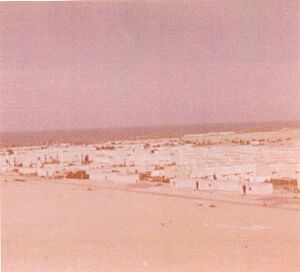
After the 1967 war, Israel built 18 settlements in the Sinai Peninsula. However, as part of the Egypt–Israel peace treaty in 1979, Israel agreed to return the Sinai to Egypt. In 1982, all Israeli citizens were moved out of these settlements, and the settlements were taken down.
Gaza Strip
Before Israel removed its settlements in 2005, there were 21 settlements in the Gaza Strip. The land was given in a way that each Israeli settler had 400 times more land than Palestinian refugees. All the buildings in the former settlements were taken down by Israel.
Are Settlements Legal?
Most countries and international groups believe that Israeli settlements in the West Bank (including East Jerusalem) and the Golan Heights are against international law. The Fourth Geneva Convention says that an occupying power should not move its own people into the land it occupies. The International Court of Justice also said in 2024 that Israel's occupation was illegal and that Israel should stop building settlements and move its citizens out.
Israel, however, says that its authorized settlements are legal and follow international law.
Some smaller settlements, called outposts, are not even approved by the Israeli government. In 2009, there were about 100 such outposts.
Land Ownership
A 1996 Israeli military rule says that private land cannot be part of a settlement unless it was taken for military reasons. However, a report from 2006 suggested that up to 40% of the land Israel plans to keep in the West Bank is privately owned by Palestinians. This was seen as a violation of Israeli law.
In 2008, the Civil Administration said that over a third of West Bank settlements were built on land taken by the Israeli army for "security reasons." The unauthorized taking of private Palestinian land was called 'theft' by the Civil Administration itself.
A secret report from 2009, called the "Spiegel report," found that some settlements considered legal by Israel were actually illegal outposts, and that large parts of settlements like Ofra and Beit El were built on private Palestinian land.
Effects on Palestinian Human Rights
Amnesty International says that Israel's settlement policy is unfair and violates the human rights of Palestinians. The building of the Israeli West Bank barrier (a wall or fence) has also been criticized because it affects Palestinian human rights and land. About 10% of the West Bank is on the Israeli side of this barrier.
In 2013, a UN Human Rights Council report looked into how Israeli settlements affect the rights of Palestinians. In February 2020, the UN published a list of 112 companies connected to activities in Israeli settlements.
Economy of Settlements
Goods made in Israeli settlements can be sold at lower prices because the Israeli government gives them a lot of money. Farmers and businesses get help, and companies in the territories receive tax breaks.
Palestinian officials believe settlers sell goods worth about $500 million to the Palestinian market. Israel has built 16 industrial zones in the West Bank and East Jerusalem. These zones help the occupation but also provide jobs for Palestinians.
However, the settlements have not developed their own strong local economy. About 60% of settlers travel to Israel for work. Most of the workers in the industrial parks are Palestinian.
Export to Europe
European Union (EU) law says that goods from Israel and goods from the occupied territories must be labeled differently. This is because goods from Israel get special customs treatment, but those from settlements do not. However, goods from settlements are often wrongly labeled as coming from Israel.
In 2019, the Court of Justice of the European Union ruled that labels on food from occupied territories must clearly state they are not from Israel itself. This helps consumers know where products come from, especially for "ethical reasons."
Palestinian Economy and Resources
A Palestinian report in 2011 said that settlements harm the Palestinian economy. It claimed that Israel and businesses profit from Palestinian natural resources and tourism. A 2013 report by the World Bank said that if Palestinians had more access to land and resources in Area C (where most settlements are), their economy could grow by about $3.5 billion each year.
The Israeli Supreme Court has said that Israeli companies can use the West Bank's natural resources for money.
Palestinian Workers
Due to jobs offering better pay and high unemployment, tens of thousands of Palestinians work in Israeli settlements. In 2013, about 20,000 Palestinians worked in settlements.
In 2007, the Supreme Court of Israel ruled that Israeli labor laws should apply to Palestinians working in West Bank settlements. This means Palestinian workers can sue in Israeli courts if their rights are not protected.
Even though the Palestinian Authority has made it illegal to work in settlements, they often don't enforce this law because of high unemployment.
Environmental Issues
Settlers and Palestinians share the same underground water source, called the mountain aquifer. Both groups produce sewage and industrial waste that can pollute this water. A 2004 study found that sewage was not treated well in many settlements, and Palestinian villages often released sewage without any treatment.
Palestinian environmentalists say that some industrial plants in the settlements create pollution because they don't follow Israeli environmental rules.
Impact on Palestinian Population
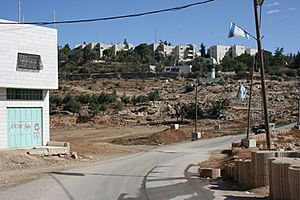
Human Rights Watch reported in 2010 that Israeli settlement policies have caused Palestinians to leave their communities. Some believe that making life difficult for Palestinians in certain areas is a way to make them leave. For example, there have been reports of Israeli authorities targeting water and electricity systems in Palestinian villages.
Education in Settlements
Ariel University is a major Israeli university in the West Bank, with nearly 13,000 students. It offers degrees in arts, sciences, technology, and more. In 2012, it was given full university status.
There are also teacher training colleges like Herzog College in Alon Shvut and Orot Israel College in Elkana.
Strategic Importance
Some Israeli plans have aimed to put a large Jewish population in certain areas to make the West Bank part of Israel. Former Prime Minister Ariel Sharon believed that placing settlements in key locations would prevent the creation of a Palestinian state.
Palestinians argue that the settlements make it impossible to have a truly independent and connected Palestinian state.
Removing Settlements
Past Removals
In 1982, as part of the peace treaty with Egypt, Israel had to remove its 18 settlements from the Sinai Peninsula. The settlements were destroyed so that settlers could not return.
In 2005, Israel removed all 21 settlements in the Gaza Strip and four in the West Bank. This was called the unilateral disengagement. Most of these settlements had been there for many years. There was strong opposition to this plan from some Israelis.
Future Ideas
Some people believe that settlements don't always have to be removed, even if Israel leaves the territory. They think settlers could stay under Palestinian rule. This idea has come from different groups, including some Israelis and Palestinians who support a two-state solution.
Impact on Peace Efforts

The settlements have caused problems between Israel and the U.S. Some U.S. presidents, like Jimmy Carter, saw them as illegal. Others, like Ronald Reagan, said they were legal but a problem for peace talks. In 2009, President Barack Obama said the U.S. "does not accept the legitimacy of continued Israeli settlements."
Palestinians say that Israel has made peace efforts harder by continuing to expand settlements. The European Union also believes Israeli settlements are illegal and make a two-state solution (where both Israel and Palestine exist side-by-side) impossible.
In 2010, Israeli Prime Minister Benjamin Netanyahu announced a 10-month pause in settlement building in the West Bank to try and restart peace talks. However, this pause did not include building in East Jerusalem or construction already underway. Palestinians refused to negotiate without a complete stop to all building.
Land Swap Ideas
Some peace proposals suggest that Israel could keep major settlement areas close to its 1967 borders. In return, Israel would give the Palestinians an equal amount of land from inside Israel. This is called a "land swap."
Palestinian Authority President Mahmoud Abbas said in 2010 that Palestinians and Israel have agreed on the idea of a land swap. However, they disagree on how much land would be swapped.
Settlement Expansion
In 2009, Prime Prime Minister Benjamin Netanyahu said he would not build new settlements but would allow for "natural growth" in existing ones. In April 2012, four illegal outposts were made legal by the Israeli government. In June 2012, plans were announced to build 851 new homes in five settlements.
In November 2013, Israel announced plans for 1,700 new homes for settlers. Later, it was revealed that plans for 24,000 more settler homes were in the works, including many east of the West Bank Barrier, deep inside the West Bank.
Between 2017 and 2019, approvals for building in Israeli settlements in East Jerusalem increased by 60%. In February 2023, the new Israeli government approved making nine illegal settler outposts legal. In June 2023, Israel made it faster to approve settlement construction. In the first six months of this new government, construction of 13,000 housing units in settlements was approved, which is almost three times the amount approved in all of 2022.
See also
- Israeli settlement timeline
- List of Israeli settlements
- Proposed Israeli annexation of the West Bank
- Kibbutz
Images for kids
-
Israeli settlers in the Ofra settlement, Israeli-occupied West Bank, 2012


